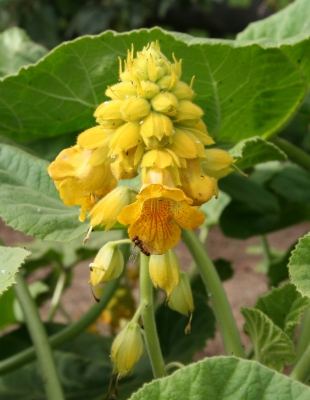Ibicella lutea
(Lindl.) Van Eselt.
Martyniaceae
Martynia lutea Lindl.
Martynia montevidensis Cham.
Proboscidea lutea Stapf
Common Name:
General Information
Ibicella lutea is a spreading, annual plant growing 30 - 60cm tall and perhaps 1 metre wide. The plant has a strong smell and is covered with a sticky exudation. Insects often become stuck and die, leading people to believe that the plant is insectivorous - it does not produce digestive enzymes, however, and the jury seems to be still out on whether it is a true insectivorous plant.
The plant is sometimes gathered from the wild for local medicinal use. It is also cultivated as an ornamental and has been grown for the young fruits in Brazil, as well as in France in the 19th century[
].
Known Hazards
The seeds have sharp, curved horns, which can attach themselves to animals feet and therefore be transported to another site[
200- Title
- The New RHS Dictionary of Gardening. 1992.
- Publication
-
- Author
- Huxley. A.
- Publisher
- MacMillan Press
- Year
- 1992
- ISBN
- 0-333-47494-5
- Description
- Excellent and very comprehensive, though it contains a number of silly mistakes. Readable yet also very detailed.
]. This can cause serious damage to the feet of some animals.
Botanical References
200- Title
- The New RHS Dictionary of Gardening. 1992.
- Publication
-
- Author
- Huxley. A.
- Publisher
- MacMillan Press
- Year
- 1992
- ISBN
- 0-333-47494-5
- Description
- Excellent and very comprehensive, though it contains a number of silly mistakes. Readable yet also very detailed.
Range
S. America - Argentina, Paraguay, Uruguay, Brazil.
Habitat
Not known
Properties
| Weed Potential | Yes |
| Edibility Rating |      |
| Medicinal Rating |      |
| Habit | Annual |
| Height | 0.50 m |
| Cultivation Status | Cultivated, Ornamental, Wild |
Cultivation Details
A plant of subtropical to tropical drier areas, where it is found at elevations from near sea level to over 1,000 metres.
Requires a sunny position in a well-drained soil.
The plant has escaped from cultivation in some areas, particularly in drier regions, and become a troublesome weed[
200- Title
- The New RHS Dictionary of Gardening. 1992.
- Publication
-
- Author
- Huxley. A.
- Publisher
- MacMillan Press
- Year
- 1992
- ISBN
- 0-333-47494-5
- Description
- Excellent and very comprehensive, though it contains a number of silly mistakes. Readable yet also very detailed.
].
It takes around 20 weeks from seed sowing to the first flowers opening[
200- Title
- The New RHS Dictionary of Gardening. 1992.
- Publication
-
- Author
- Huxley. A.
- Publisher
- MacMillan Press
- Year
- 1992
- ISBN
- 0-333-47494-5
- Description
- Excellent and very comprehensive, though it contains a number of silly mistakes. Readable yet also very detailed.
].
Edible Uses
The young fruits are pickled or eaten as sweetmeats[
301- Title
- Cornucopia II
- Publication
-
- Author
- Facciola. S.
- Publisher
- Kampong Publications, California.
- Year
- 1998
- ISBN
- 0-9628087-2-5
- Description
- The second edition of an excellent guide to the edible uses of plants, though it does not give any details of cultivation etc.
,
].
Medicinal
The seeds are emollient, resolvent[
46- Title
- Dictionary of Economic Plants.
- Publication
-
- Author
- Uphof. J. C. Th.
- Publisher
- Weinheim
- Year
- 1959
- ISBN
- -
- Description
- An excellent and very comprehensive guide but it only gives very short descriptions of the uses without any details of how to utilize the plants. Not for the casual reader.
]. They are used as a poultice[
46- Title
- Dictionary of Economic Plants.
- Publication
-
- Author
- Uphof. J. C. Th.
- Publisher
- Weinheim
- Year
- 1959
- ISBN
- -
- Description
- An excellent and very comprehensive guide but it only gives very short descriptions of the uses without any details of how to utilize the plants. Not for the casual reader.
].
Other Uses
None known
Propagation
Seed - pre-soak for 24 hours in warm water then sow in situ in a warm, sunny position.
If you have any useful information about this plant, please leave a comment. Comments have to be approved before they are shown here.








 Useful Tropical Plants Database 2014 by
Ken Fern,
web interface by
Ajna Fern
with help from
Richard Morris.
Useful Tropical Plants Database 2014 by
Ken Fern,
web interface by
Ajna Fern
with help from
Richard Morris.